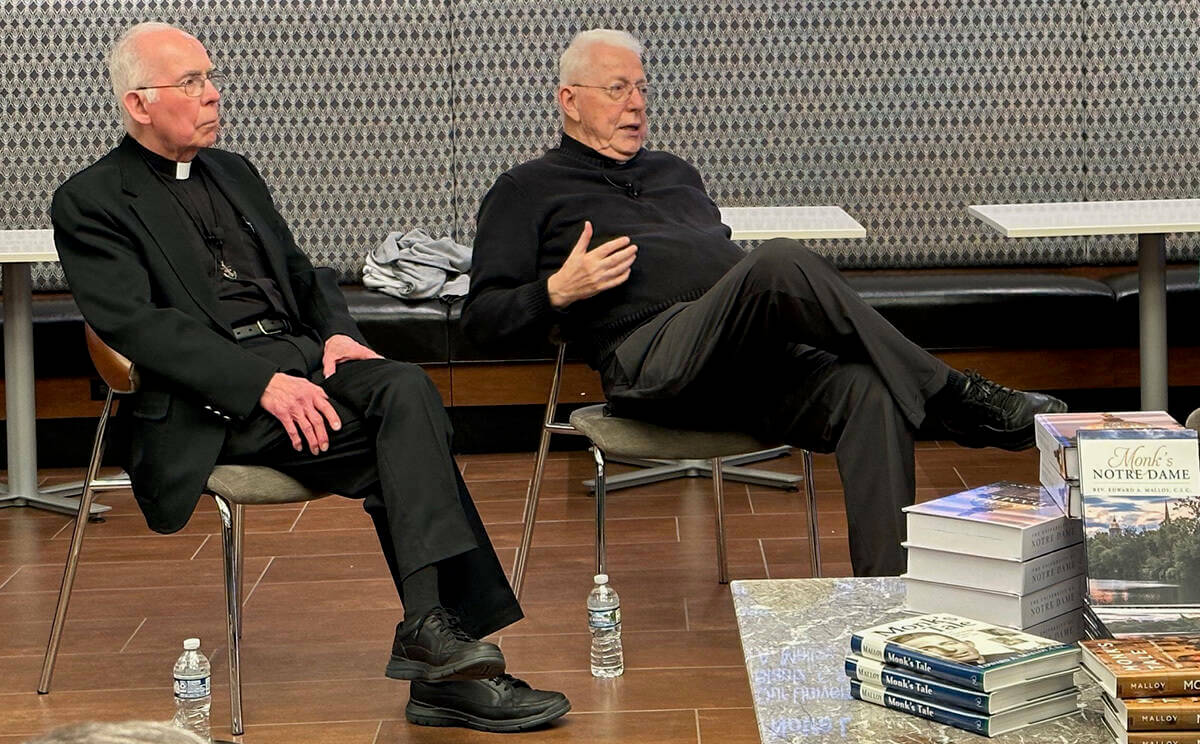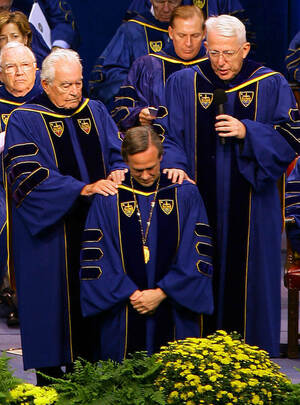
When two Holy Cross priests got together to discuss their decades of experience at Notre Dame, some topics were expected (their first impressions of campus) and others less so (pest control and marbles).
The two are well-known figures on campus: Rev. Edward A. “Monk” Malloy, CSC, ’63, ’67M.A., ’69M.A., the University president emeritus; and Rev. Thomas E. Blantz, CSC, ’57, ’63M.A., a professor emeritus of history, former administrator and former University archivist.
With more than 130 years of service on campus between them, Malloy and Blantz have observed a lot of history firsthand.
The two priests were featured speakers on November 15 during the annual Notre Dame Press Book Festival in Hesburgh Library. The conversation was moderated by Kathleen Sprows Cummings ’94M.A., ’99Ph.D., the Rev. John A. O’Brien Collegiate Professor of American Studies and History.
They answered questions and spoke about their lives at the University. Both men have written books: Malloy, several volumes of memoirs and a new title, People First: Reflections on Leadership (2023); and Blantz, The University of Notre Dame: A History (2020).
Following are selections from the conversation.
What was Notre Dame like when you first arrived?
Blantz arrived on campus in 1948 as a 14-year-old high school seminarian, living in Holy Cross Seminary (later Holy Cross Hall) on the north bank of Saint Mary’s Lake. The high school seminary program ended in 1967.
“I had a very good education, met some wonderful people and got to know Holy Cross very well. I was discerning whether I wanted to stay and become a Holy Cross priest,” Blantz recalled. He later earned two Notre Dame degrees and was ordained in 1960.
Malloy, Notre Dame’s president from 1987 to 2005, took a very different path to the University. “I was on this very successful high school basketball team in Washington, D.C.,” he said. “I had about 60-some (athletic scholarship) offers and I narrowed my schools down to Villanova, Notre Dame and Santa Clara. I wanted to go to a Catholic school.”
He enrolled as an engineering major, because a priest at his high school convinced students they needed to go into science or engineering to beat the Soviets after the USSR launched Sputnik, the first artificial satellite. “So I signed up for chemical engineering even though I had no idea what an engineer did,” Malloy said. He graduated as an English major.
“I loved it from the first day I was here. I never had any homesickness. I never thought about going somewhere else,” Malloy said. “I’m very thankful that my college education was paid for by an athletic scholarship. I’m thankful that I got accepted by (the Congregation of) Holy Cross when I discerned my vocation. I’ve been given a lot of opportunities as a result of that.”

On the multiple roles many priests have, serving also as teachers and administrators:
“As a Holy Cross priest, I think leadership is an integral part of our charism — teaching and leadership are not discrepant,” Malloy said. “For me, leadership was also a form of teaching, of learning, of participation in the common life. And I think that’s the way it ought to be seen.” He continued to teach while holding administrative offices, including the presidency.
Malloy has lived in the same room in Sorin Hall since 1979. “When I was elected president, the trustees said, ‘That will never last more than six months (when you’re) president.’ It’s 44 years and I'm still there.”
Blantz said he once asked Rev. John J. Cavanaugh, who preceded Rev. Theodore M. Hesburgh as Notre Dame president, whether he missed the honor and prestige of leading the University after he left office.
Cavanaugh told him there’s no prestige or honor in being an administrator. “He said, ‘You’re like the stable boys in a racetrack.’ He said that the important thing at a racetrack are the horses and the jockeys. He said, ‘You’re there just to make sure that the water’s there and the food is there and you shovel out what shouldn’t be there,’” Blatz recalled.
The important people are the faculty and the students, and the administrators are just there to make sure the place is running smoothly, he said.
Rev. John I. Jenkins, CSC, ’76, ‘78M.A. will be stepping down as Notre Dame’s president in June 2023. (Rev. Robert A. Dowd, CSC, ’87 will be the next president.) What advice do you have for Jenkins after he leaves office?
“Get out of here for a year,” said Malloy, who recalled he took various trips during his first year as president emeritus and kept a low profile on campus. He watched Notre Dame football games on TV rather than in-person in Notre Dame Stadium.

What was the happiest day of your presidency?
“I could say when we won the national championship multiple times in multiple sports,” Malloy said. “Those were all really happy days.”
Malloy also said one of the happiest days of his life was one on which an iconic photograph was taken. It was on the day of Jenkins’ inauguration and it shows Malloy and Hesburgh bestowing a blessing on the new president.
“When Ted and I laid hands on John Jenkins at his inauguration ceremony — because I think that represents continuity, the presence of the Holy Spirit, multiple generations of leadership, and I was glad after my years of service to be able with confidence to celebrate the new president,” Malloy recalled.
What were the popular sports at Notre Dame before football?
Baseball was popular among 19th century Notre Dame students, but also — perhaps surprisingly — marbles competitions, Blantz said. “The rumor was that (Father) Sorin was very good at marbles,” he added. “I have no idea whether it’s true or not.”
On the role football — and other sports — have had in Notre Dame history:
It was in the 1920s under coach Knute Rockne that Notre Dame’s football team brought fame and game proceeds that helped to strengthen the University, Blantz said. “Then the Depression hit and we had money to build the (South) Dining Hall, Dillon, Alumni, the law school and various things like this,” he said. Football was crucial in developing Notre Dame’s national profile — its fame, its fans and the athletic income that built the modern campus, Blantz said.
Malloy noted the NCAA was founded to regulate the rules of college sports after years of serious injuries and deaths among players on the unregulated football playing fields. “I think if the NCAA didn't exist, we’d have to create something like it,” he said.
“A residential campus is an ideal place to try to have every available sport that’s of interest to people,” Malloy said. “And one of the great transformations in my time has been the acceleration of quality in the women’s sports, who won national championships in various areas. That’s something to be proud of.”
Recounting experiences during and after the 1972 transition to co-education:
Blantz recalled living as the priest-in-residence in Cavanaugh Hall, a men’s dorm, which then became a women’s dorm. One day the hall president stopped by his room and asked if he was afraid of cockroaches. He said no. “She asked, ‘What do you do with them?’ I said, ‘You kill them.’ She said, ‘How do you kill them?’ I said, ‘You step on them.’” That’s how Blantz found himself invited into the women’s shower room to kill a cockroach.
“I said, ‘Well, make sure there are no girls in the shower.’ And she said, ‘If there’s a cockroach in there, there are no girls in the shower.’ And I became a hero. In 17 years in a men’s hall, I was never asked to kill a cockroach.”
If you were founding a university from scratch today, would you have a football program?
“Yes, I like college football. I think we need to do what we can to reform its structure and to make it as fair as possible,” Malloy said. “Is it doable? Only time will tell. I don't expect to be watching marbles in the stadium anytime soon.”
Margaret Fosmoe is an associate editor of this magazine. Contact her at mfosmoe@nd.edu or @mfosmoe.